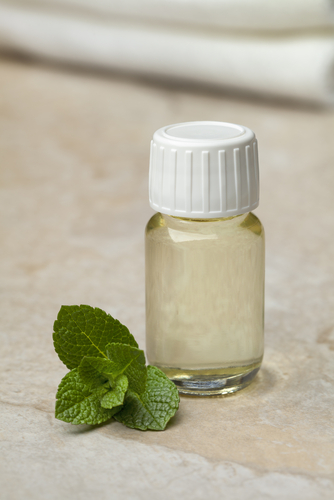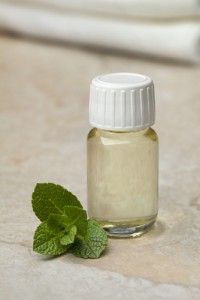Cystic Fibrosis Foundation’s Peppermint Oil in Nebulizers Warning Well-Founded, But Teen Researcher’s Findings Merit Further Investigation

 Complimentary therapeutic approaches are nothing if not controversial in conventional medicine and mainstream organizations offering information and support for those afflicted with particular diseases. This leaning toward cautious conservatism is commendable, as there is usually plenty of unsubstantiated advice around — often associated with the sale of scientifically unproven nostrums that may or may not offer some benefit, but the old “if it seems too good to be true, it probably is” axiom usually applies. However, hopefully alternative therapies that actually might confer real benefits with fewer unwanted side-effects than conventional methods aren’t getting kicked to the curb along with.
Complimentary therapeutic approaches are nothing if not controversial in conventional medicine and mainstream organizations offering information and support for those afflicted with particular diseases. This leaning toward cautious conservatism is commendable, as there is usually plenty of unsubstantiated advice around — often associated with the sale of scientifically unproven nostrums that may or may not offer some benefit, but the old “if it seems too good to be true, it probably is” axiom usually applies. However, hopefully alternative therapies that actually might confer real benefits with fewer unwanted side-effects than conventional methods aren’t getting kicked to the curb along with.
Last week the Cystic Fibrosis Foundation (CFF) posted an alert about a high schooler’s science experiment presented at the 2013 Intel International Science and Engineering Fair, entitled “Pseudomonas A. Infections In The Cystic Fibrosis Lung: The Inhibition Of Bio-encapsulated Pathogens Within Simulated Cystic Fibrosis Conditions” in which the teen claimed that peppermint oil can kill a bacteria that frequently affects CF patients, without use of antibiotics. If substantiated, such an alternative approach to treating such infections would be consistent with te objective of finding alternatives to antibiotics in aid of fighting the superbug problem, which is no trivial concern. Last month, the World Health Organization (WHO) released a 257-page report on antimicrobial resistance (AMR), warning that within a wide range of infectious agents is a growing public health threat of broad concern to countries and multiple sectors — a problem so serious that it threatens the achievements of modern medicine. The report notes that a post-antibiotic era—in which common infections and minor injuries can kill is now far beyond being an apocalyptic fantasy, and is a very real possibility for the 21st century. The report, based on data from 114 countries, makes a clear case that resistance to common bacteria has reached “alarming levels” in many parts of the world indicating that many of the available treatment options for common infections in some settings are becoming ineffective, and moreover, systematic reviews of scientific evidence show that ABR has a negative impact on outcomes for patients and health-care expenditures.
Against that backdrop, it would seem that no stone ought to be left unturned in the quest to find effective alternatives to conventional antibiotic therapies.
The notice, entitled “CF Foundation Recommends Against Using Peppermint Oil in Nebulizer,” notes that some members of the CF community had enquired about the effectiveness of using peppermint oil in their nebulizers, their interest based on an in vitro study presented at last year’s Intel-sponsored student science fair suggesting peppermint oil has a comparable effect on the pathogenic bacterium Pseudomonas a. to that of a comparison antibiotic drug, tetracycline.
The CFF concedes that small doses of peppermint oil taken orally appear to be safe, but contends that there are no data suggesting peppermint oil is safe when taken by nebulizer and warns that such use may cause a form of pneumonia (lipoid pneumonia – a lung inflammation that develops from aspirating or inhaling fat-like oily material into the bronchial tree). Consequently, the CF Foundation “strongly recommends against using peppermint oil with nebulizer therapy.”
Intel appears to have deleted a feature article it had posted last year about the high-schooler’s research project, although the project abstract is still in the Intel ISEF Projects Database. Search engines (Google, Bing) still turn up a link to the original Intel article, but when clicked render a page of article and video links with no mention of said article. A CF NewsToday request for to Intel’s media department for comment had received no response at this writing. However, a topic search of the Intel site still leads to a video “CF’s Slime-Fighter” of the impressively well-spoken teen researcher explaining her project and the reasons for her interest in CF. The video is also available on YouTube.
[adrotate group=”1″]
At time of publication, an apparently slightly truncated version of the Intel article, entitled “Deadly Pseudomonas Cystic Fibrosis Bacterium Meets Minty Nemesis” could still be found on a Polish Website. The article states that Pseudomonas aeruginosa, a common bacterium, leads to fatality in 65 percent of cases for cystic fibrosis (CF) patients because antibiotics cannot effectively penetrate a slimy biofilm it creates in the lungs, and that “convinced there is a better way to treat afflicted CF patients, 2013 Intel International Science and Engineering Fair1 (Intel ISEF) participant Jenna Hartley discovered a potential — and natural — alternative to antibiotic treatment: peppermint oil.”
The article goes on to note that the project researcher, then 16-year-old Jenna Hartley, a student at Palmer High School in Colorado Springs, Colorado, was concerned about the growing problem of antibiotic resistance, and had already begun investigating natural alternatives when the plight of a childhood friend was diagnosed with CF, which added a new sense of urgency to her research.
Ms. Hartley examined natural agents, including Mentha piperita (peppermint oil), to determine if any had potential to break through the biofilm slime and attack the bacteria, comparing results to the standard antibiotic treatment, tetracycline.
In her study abstract, posted on the University of Colorado Website, Ms. Hartley observes that “Research on natural products as antimicrobial agents has almost exclusively focused on the effects of these against planktonic micro-organisms. However, the biofilm forms that are more resistant to antimicrobial agents, and therefore more difficult to control, remain largely unexplored.
In this study, Ms. Hartley researched the effect of plant extracts of Terminalia Chebula, Echinacea dissolved in alcohol as well as in a non-alcoholic solution, and m. Piperita (Peppermint oil), on the development of microbial biofilms of the pathogen Pseudomonas aeruginosa.
She says that the salient point of her project was to measure the inhibition of the biofilm of Pseudomonas a. developed within extremely viscous conditions that mimic an environment of a cystic fibrosis lung using an artificial mucus, and that the anti-microbial properties of these herbal extracts would be investigated in order to test the hypothesis that they inhibit the microbial and biofilm growth.
Ms. Hartley observes that the extract showing the highest level of antimicrobial activity was that of Echinacea dissolved in alcohol but the inhibition was due to the alcohol solvent vehicle rather than qualities of the herb itself. However, she discovered that the agent demonstrating the highest inhibition of the biofilm without the presence of alcohol was m. Piperita, and that m. Piperita developed within cystic fibrosis conditions was able to match the antimicrobial capabilities of Tetracycline, and additionally, without the presence of mucus, peppermint oil was able to surpass the capabilities of conventional antibiotic treatment as well, leading to the conclusion that the reduction of biofilm biomass demonstrated using plant extracts shows potential for development of medicinal products that will prevent microbial adhesion thus reducing the incidence of infections associated with biofilm formation.
Much more research and peer review would of course be required before such a concept could be accepted as an approved treatment for Pseudomonas a. infections, but Ms. Hartley would appear to be on to something that could be hugely beneficial in several contexts if it can be proven in subsequent research, and she says hopes to see her work progress into clinical trials involving human subjects, some perhaps involving her at the grad school level, as she pursues a career in medical research. We can only wish her every success in achieving those aspirations.
So what is known about hazards associated with use of m. Piperita essential oil in nebulizers? According to the National Institutes of Heath (NIH) drug info site, peppermint is used medicinally for the common cold, cough, inflammation of the mouth and throat, sinus infections, respiratory infections, digestive problems including heartburn, nausea, vomiting, morning sickness, irritable bowel syndrome (IBS), cramps of the upper gastrointestinal (GI) tract and bile ducts, upset stomach, diarrhea, bacterial overgrowth of the small intestine, and gas — also for menstrual problems, liver and gallbladder complaints, preventing spasms during endoscopy procedures, and as a stimulant. Peppermint oil is is applied to the skin for headache, muscle pain, nerve pain, toothache, inflammation of the mouth, joint conditions, itchiness, allergic rash, bacterial and viral infections, relaxing the colon during barium enemas, for repelling mosquitoes, as a painkiller, and some people inhale peppermint oil for treating symptoms of cough and colds — one of the very few references I unearthed on breathing peppermint oil vapors.
The NIH notes that In 1990, the FDA banned the sale of peppermint oil as an over-the-counter drug for use as a digestive aid because its effectiveness had not been proven, so today peppermint is sold as a dietary supplement, and is LIKELY SAFE when taken by mouth in amounts commonly found in food; POSSIBLY SAFE when taken in medicinal amounts or when applied to the skin, and the leaf is POSSIBLY SAFE when taken in amounts used for medicine short-term (up to 8 weeks), but it can cause some side effects including heartburn, and allergic reactions including flushing, headache, and mouth sores. Peppermint oil, when taken by mouth in pills with enteric coating to prevent contact with the stomach and heartburn is LIKELY SAFE for children 8 years of age and older, although there are contraindications and moderate potential for interaction with other medications that should be checked out before using peppermint medicinally. Some are listed here:
https://www.nlm.nih.gov/medlineplus/druginfo/natural/705.html
The University of Maryland Medical Center also has a site covering safety and potential drug interactions with medicinal use of peppermint.
Another NIH site notes that results from several studies suggest that peppermint oil may improve symptoms of irritable bowel syndrome, and a few studies have found that in combination with caraway oil, peppermint oil may help relieve indigestion, but evidence is preliminary, and although there are some promising results, there is no clear-cut evidence to support use of peppermint oil for other health conditions. Again, more research is logically indicated in hope of building on those “promising results.”
Wikipedia notes that in 2007, Italian investigators reported that 75% of the patients in their study who took peppermint oil capsules for four weeks had a major reduction in irritable bowel syndrome (IBS) symptoms, compared with just 38% of those who took a placebo, and that a second study conducted in Iran in 2010,found similar results. The article says according to monographs from the German Commission E scientific advisory board of the Bundesinstitut für Arzneimittel und Medizinprodukte (the German equivalent of the FDA) that gives scientific expertise for approval of substances and products previously used in traditional, folk and herbal medicine, peppermint oil (as well as peppermint leaf) has been used internally as an antispasmodic (upper gastrointestinal tract and bile ducts) and to treat irritable bowel syndrome, catarrh of the respiratory tract, and inflammation of the oral mucosa; and externally for myalgia and neuralgia, and may also act as a carminative, cholagogue, antibacterial, and secretolytic, as well as having a cooling action.
Not much found about using peppermint oil in nebulizers or vaporizers, pro or con, but it is evidently powerful stuff, a potential irritant, and the Cystic Fibrosis Foundation is consequently well-justified advising caution in experimenting with it for respiratory infections. Lipoid pneumonia sounds like no fun at all. But let’s please have more research into peppermint oil’s potential as an antimicrobial alternative using a safer mode of delivery.
Sources:
Jenna Pauline Hartley: “Pseudomonas A. Infections In The Cystic Fibrosis Lung: The Inhibition Of Bio-encapsulated Pathogens Within Simulated Cystic Fibrosis Conditions”
World Health Organization
Intel Corp.
Cystic Fibrosis Foundation
National Institutes of Heath
University of Maryland Medical Center
Wikipedia
www.mati-szostak.pl








